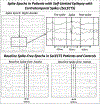Connectivity increases during spikes and spike-free periods in self-limited epilepsy with centrotemporal spikes
- PMID: 36307364
- PMCID: PMC10883644
- DOI: 10.1016/j.clinph.2022.09.015
Connectivity increases during spikes and spike-free periods in self-limited epilepsy with centrotemporal spikes
Abstract
Objective: To understand the impact of interictal spikes on brain connectivity in patients with Self-Limited Epilepsy with Centrotemporal Spikes (SeLECTS).
Methods: Electroencephalograms from 56 consecutive SeLECTS patients were segmented into periods with and without spikes. Connectivity between electrodes was calculated using the weighted phase lag index. To determine if there are chronic alterations in connectivity in SeLECTS, we compared spike-free connectivity to connectivity in 65 matched controls. To understand the acute impact of spikes, we compared connectivity immediately before, during, and after spikes versus baseline, spike-free connectivity. We explored whether behavioral state, spike laterality, or antiseizure medications affected connectivity.
Results: Children with SeLECTS had markedly higher connectivity than controls during sleep but not wakefulness, with greatest difference in the right hemisphere. During spikes, connectivity increased globally; before and after spikes, left frontal and bicentral connectivity increased. Right hemisphere connectivity increased more during right-sided than left-sided spikes; left hemisphere connectivity was equally affected by right and left spikes.
Conclusions: SeLECTS patient have persistent increased connectivity during sleep; connectivity is further elevated during the spike and perispike periods.
Significance: Testing whether increased connectivity impacts cognition or seizure susceptibility in SeLECTS and more severe epilepsies could help determine if spikes should be treated.
Keywords: Benign Epilepsy with Centrotemporal Spikes (BECTS); Childhood Epilepsy with Centrotemporal Spikes (CECTS); Connectivity; Interictal epileptiform discharges (IEDs); Rolandic epilepsy; Sleep.
Copyright © 2022 International Federation of Clinical Neurophysiology. Published by Elsevier B.V. All rights reserved.
Conflict of interest statement
Declaration of interest None.
Figures





Comment in
-
Brain Connectivity: When too much of a good thing is not so good.Clin Neurophysiol. 2022 Dec;144:117-118. doi: 10.1016/j.clinph.2022.09.016. Epub 2022 Oct 7. Clin Neurophysiol. 2022. PMID: 36244914 No abstract available.
References
-
- Apache Arrow Team, Apache Arrow. PyArrow python bindings to the Apache Arrow project, a development platform for in-memory analytics. 2022. (PyArrow version 5.0.0) [Online accessed Oct 2020, updated Dec 2021, Aug 2022] Apache Software Foundation. https://arrow.apache.org/docs/python/index.html
-
- Berg AT, Berkovic SF, Brodie MJ, Buchhalter J, Cross JH, van Emde Boas W, et al. Revised terminology and concepts for organization of seizures and epilepsies: Report of the ILAE Commission on Classification and Terminology, 2005–2009. Epilepsia 2010;51:676–85. 10.1111/j.1528-1167.2010.02522.x. - DOI - PubMed
Publication types
MeSH terms
Grants and funding
LinkOut - more resources
Full Text Sources

